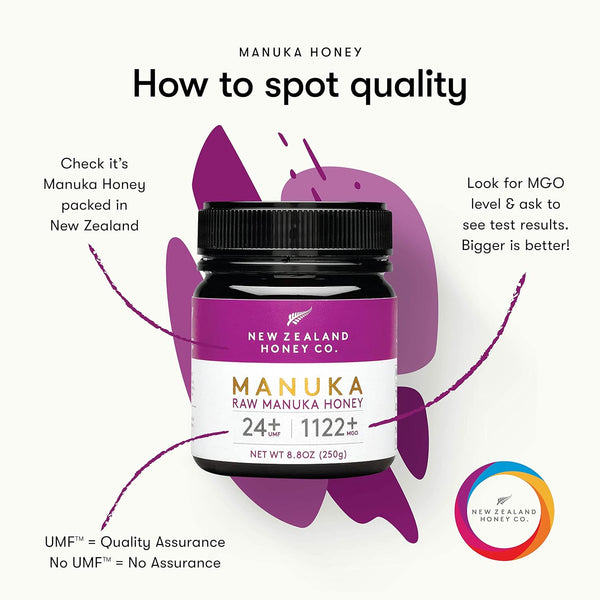UMF™ to MGO Calculators
Use our quick and easy UMF to MGO calculators to understand their relative values.
UMF™ to MGO Calculator
MGO to UMF™ Calculator
UMF/MGO matching values are rounded to the nearest equivalent. While accurate, we recommend using this UMF/MGO calculator as a guide.
On this page, you’ll find a table that compares UMF™ vs MGO numbers to help you better understand the potency of your New Zealand manuka honey.
Keep reading to find out what MGO and UMF™ are, which grading system is best, and why we use the UMF™ system. Or if you’d like to jump straight to our visual comparison table, click here.
Why do we use manuka honey grading systems?
Manuka honey has been widely researched over the last 30+ years, and found to offer an extraordinary range of health benefits. This is partly thanks to its high levels of a compound called methylglyoxal (or MGO for short), along with a range of other nutrients that naturally occur in the honey.
As a result, it’s in high demand, and there are often fake or inferior quality products sold under the ‘manuka honey’ label. To help protect consumers and ensure that you know what you’re buying, a range of grading systems were developed.
UMF™ is the most popular and trustworthy grading system, followed by MGO. But how do they differ? And what do you really need to know? Let’s take a look…

Are UMF™ and MGO the same?
No. UMF™ is one of the most widely used manuka honey grading systems throughout the world. It is the most reliable system because of its comprehensive and robust testing approach. MGO looks at one chemical marker - methylglyoxal.
UMF™ measures the concentration of methylglyoxal levels (also known as MGO or MG), but it also includes additional testing of other compounds that serve as authenticity markers to ensure that you’re buying the real deal, that your honey is fresh, and it has a long shelf life.
Here’s an overview of what each system tests for…
UMF™ grading includes:
- Methylglyoxal levels (MGO/MG) - this shows us how potent the honey is, indicating which purposes it should be used for.
- Leptosperin - this tells us that the manuka honey is authentic, and definitely came from the mānuka flower.
- Dihydroxyacetone (DHA) - this is found in the nectar of the mānuka flower, and slowly converts into MGO over time. High levels of DHA indicate a long shelf life.
- Hydroxymethylfurfural (HMF) - this indicates that the honey has not been overheated or stored for too long. By measuring HMF, we can know how fresh the honey is, to ensure that it’s in the right conditions to maintain its health benefits over time.
MGO grading measures:
- Methylglyoxal levels (MGO/MG) - the MGO system focuses entirely on potency, which leaves the potential for honey to be less than authentic, fresh, and long-lasting.
So if you’re looking to buy authentic manuka honey, make sure that it has a UMF™ logo from a reputable brand.
UMF™ is only ever made from monofloral manuka honey
When bees produce honey, they harvest the nectar from nearby flowers, which is brought back to the hive and partially digested to reduce its water content. They can travel up to 5km to find nectar, which usually means that bees have the opportunity to visit non-mānuka flowers as well.
For a batch of manuka honey to earn a UMF™ grade, it needs to be considered ‘monofloral’. This means that most or all of the nectar came from one plant source (in this case, the mānuka plant) and that it hasn’t been blended with other honey.
Learn more:
- What is monofloral manuka honey and why does it matter?
- How do bees make honey?
- What is UMF™ in manuka honey?
MGO vs UMF™: which manuka honey grading system is the best?
Aside from UMF™ and MGO, there are other manuka honey grading systems that have been developed over the years. However, none of them are comparable in reliability to UMF™, so we are not including them here.
If you’d like to learn more about the other manuka honey systems, check out this article.
By this stage, you’ve probably gathered that we prefer (and use) UMF™ because the testing is much more comprehensive and guarantees that consumers get a high-quality, trustworthy, fresh product.
This aligns with our commitment to transparency, quality, and thorough testing. We’re also accredited as non-GMO, glyphosate residue-free, Halal and Kosher certified, and more.
Learn about our accreditations here. Or shop our range here.
UMF™ vs MGO Comparison Table
Here’s a manuka honey MGO chart so that you can compare the MGO to UMF™ conversion rates and decide which honey is best for you.
Find the right UMF™ grade for your needs
If you’re new to the world of manuka honey, all these different numbers can feel a bit overwhelming. To help make it easier for you, we developed a quick quiz that will share which grade is right for your needs.
Get your authentic, raw, UMF™ grade manuka honey right here
Do you want to buy real manuka honey from a trustworthy brand? Then you’re in the right place.
Our jars range from UMF™ 5+ all the way up to UMF™ 28+. We partner with the best beekeepers, and pay attention to detail at each stage of the journey from hive to table - so that you get nothing less than the best.
Shop our range here.